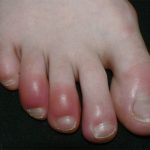 Small, itchy, painful lumps that develop on the skin. They develop as an abnormal response to cold. Also called perniosis or blain.
Small, itchy, painful lumps that develop on the skin. They develop as an abnormal response to cold. Also called perniosis or blain.
Inflammation or blister of the hands and feet caused by exposure to cold or moisture.
A chronic injury of the hands or feet characterized by reddish skin, burning, itching, and chapping and ulceration is caused by repeated or prolonged exposure to damp cold, frostbite.
A condition in which the skin of the fingers, toes, nose or ears becomes red, swollen and itchy because of exposure to cold.
A red round itchy swelling of the skin, occurring generally on the fingers or toes in cold weather. Chilblains form part of a group of related conditions. Treatment is by keeping the limbs warm, though vasodilator drugs may help.
Chilblain, or erythema pernio, is an inflamed condition of the hands or feet, or occasionally of the ears, and should not be confused with cracked or chapped hands. Most commonly found in childhood and old age, it may be associated with generally poor health, though there may also be a genetic predisposition. Prevention with good food, warm clothing, a warm environment, and regular exercise to maintain the circulation, is the best treatment.
A mild form of cold injury marked by localized redness, burning, and swelling on exposed body parts, especially in cool, damp climates. The affected skin sometimes blisters or ulcerates. Insufficient blood flow into small blood vessels in the skin may contribute to the formation of chilblains.
Chilblains, characterized by a pruritic and purplish-red swelling, typically localized on the digits such as toes or fingers, arise due to the excessive constriction of tiny blood vessels beneath the skin’s surface when exposed to cold temperatures. This condition is most frequently encountered among young children and the elderly, with women exhibiting higher susceptibility. Generally, chilblains resolve spontaneously without necessitating medical intervention.
A red, swollen, irritating area usually localized to those parts of the body at the ends of the circulation, such as the heels, the back of the calves, and the flap of the ear. Chilblains are in effect areas of paralyzed or sluggish circulation—hence their congested appearance. Since chilblains are caused or aggravated by cold and damp, every effort should be made to avoid or remove these two possible causes. Suitable clothing should be worn to keep the circulation warm and active, standing on cold surfaces such as tiled or concrete floors should be avoided, and so should sedentary occupations. Tight garters, tight elastic in the legs of children’s knickers, overtight shoes or stockings, and any constriction that tends to slow the circulation should be removed, and every effort be made to stimulate the circulation by vigorous exercise. Numerous remedies have been advocated, from thyroid tablets, calcium tablets, and large doses of vitamin D2 , down to tablets of nicotinamide, which dilate the peripheral circulation. No one treatment works in all cases. In mild cases of early chilblain formation a lot can be done by rubbing the chilblains with lotion if ulceration has not started. An old-fashioned treatment that works in some cases of early chilblains is to place the hands or feet into a bowl of lukewarm water and then add boiling water until the water in the bowl is as hot as the patient can tolerate. This dilates the circulation and may help to stop or reverse the stagnation in the chilblain. Also called pernio.
